Financial Resource Management Report: Analysis of Financial Decisions
VerifiedAdded on 2019/12/03
|24
|3996
|149
Report
AI Summary
This report provides a comprehensive analysis of financial resource management within a business context. It begins by identifying and evaluating various sources of finance, including internal and external options, and discusses the implications of each. The report then delves into financial planning and decision-making processes, highlighting the importance of financial statements and their role in informing key decisions. It includes examples of financial statements like the income statement and balance sheet. Further, the report examines sales budgets, cash flow forecasts, and investment appraisal methods, such as ARR, IRR, and NPV, along with costing and pricing strategies. Finally, the report concludes by analyzing financial performance through accounting terminology and ratio evaluation. The report includes tables and figures to illustrate key concepts and data.

MFRD
Paraphrase This Document
Need a fresh take? Get an instant paraphrase of this document with our AI Paraphraser
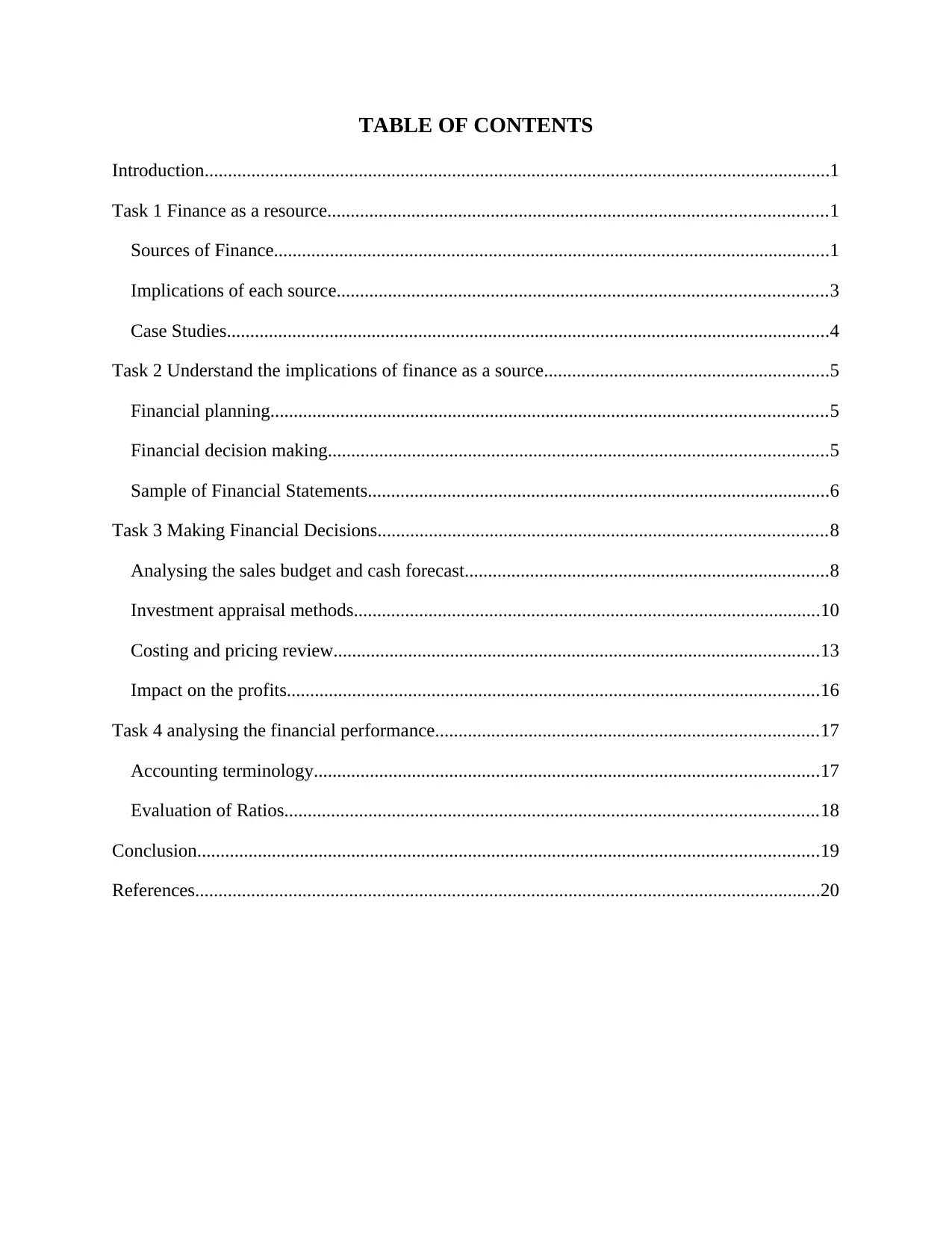
TABLE OF CONTENTS
Introduction......................................................................................................................................1
Task 1 Finance as a resource...........................................................................................................1
Sources of Finance.......................................................................................................................1
Implications of each source.........................................................................................................3
Case Studies.................................................................................................................................4
Task 2 Understand the implications of finance as a source.............................................................5
Financial planning.......................................................................................................................5
Financial decision making...........................................................................................................5
Sample of Financial Statements...................................................................................................6
Task 3 Making Financial Decisions................................................................................................8
Analysing the sales budget and cash forecast..............................................................................8
Investment appraisal methods....................................................................................................10
Costing and pricing review........................................................................................................13
Impact on the profits..................................................................................................................16
Task 4 analysing the financial performance..................................................................................17
Accounting terminology............................................................................................................17
Evaluation of Ratios..................................................................................................................18
Conclusion.....................................................................................................................................19
References......................................................................................................................................20
Introduction......................................................................................................................................1
Task 1 Finance as a resource...........................................................................................................1
Sources of Finance.......................................................................................................................1
Implications of each source.........................................................................................................3
Case Studies.................................................................................................................................4
Task 2 Understand the implications of finance as a source.............................................................5
Financial planning.......................................................................................................................5
Financial decision making...........................................................................................................5
Sample of Financial Statements...................................................................................................6
Task 3 Making Financial Decisions................................................................................................8
Analysing the sales budget and cash forecast..............................................................................8
Investment appraisal methods....................................................................................................10
Costing and pricing review........................................................................................................13
Impact on the profits..................................................................................................................16
Task 4 analysing the financial performance..................................................................................17
Accounting terminology............................................................................................................17
Evaluation of Ratios..................................................................................................................18
Conclusion.....................................................................................................................................19
References......................................................................................................................................20

LIST OF FIGURES
Figure 1: Source of Finance.............................................................................................................1
Figure 2 Positive and Negative implications of Internal Sources....................................................3
Figure 3: Positive and Negative implications of External Sources.................................................4
Figure 1: Source of Finance.............................................................................................................1
Figure 2 Positive and Negative implications of Internal Sources....................................................3
Figure 3: Positive and Negative implications of External Sources.................................................4
⊘ This is a preview!⊘
Do you want full access?
Subscribe today to unlock all pages.

Trusted by 1+ million students worldwide
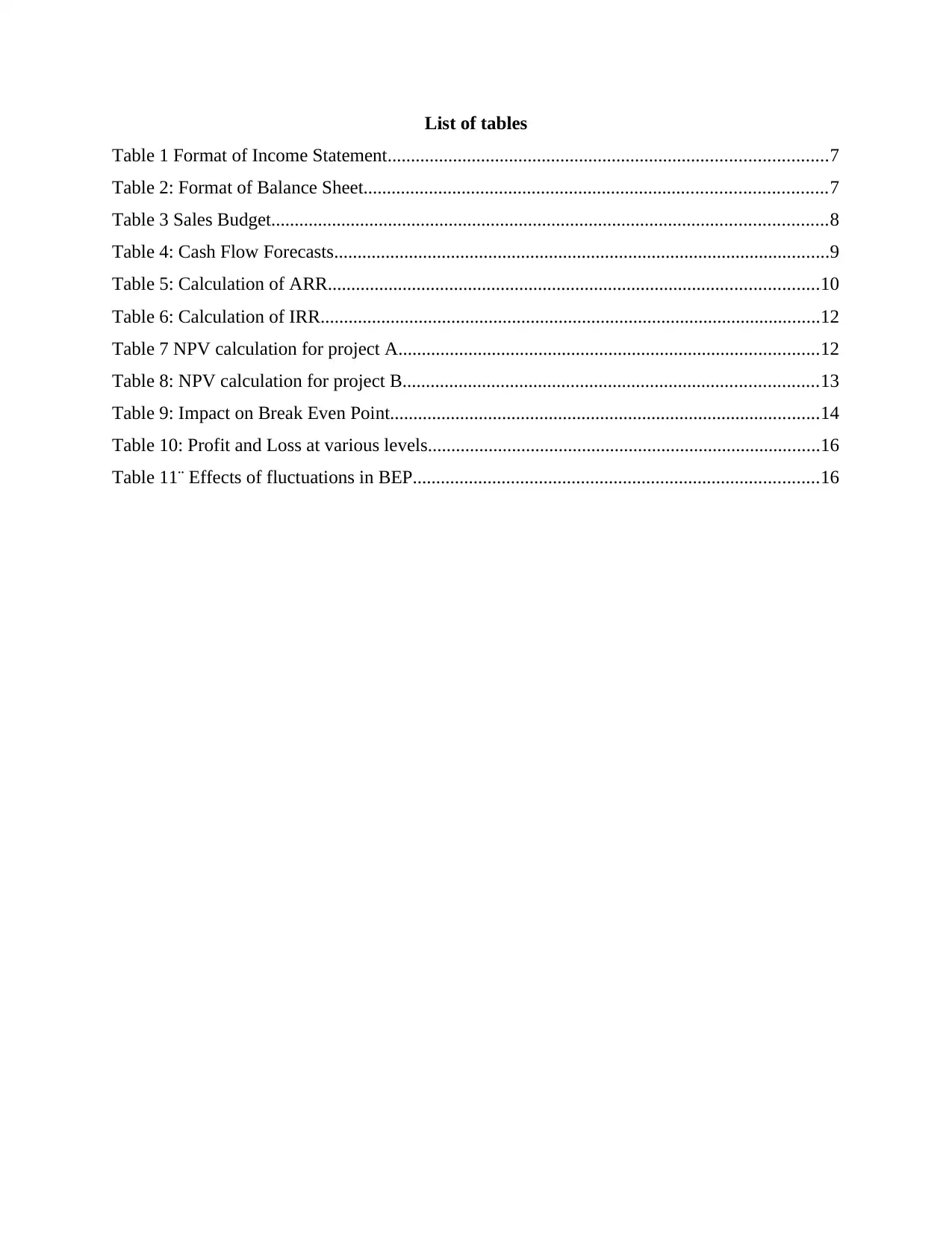
List of tables
Table 1 Format of Income Statement..............................................................................................7
Table 2: Format of Balance Sheet...................................................................................................7
Table 3 Sales Budget.......................................................................................................................8
Table 4: Cash Flow Forecasts..........................................................................................................9
Table 5: Calculation of ARR.........................................................................................................10
Table 6: Calculation of IRR...........................................................................................................12
Table 7 NPV calculation for project A..........................................................................................12
Table 8: NPV calculation for project B.........................................................................................13
Table 9: Impact on Break Even Point............................................................................................14
Table 10: Profit and Loss at various levels....................................................................................16
Table 11¨ Effects of fluctuations in BEP.......................................................................................16
Table 1 Format of Income Statement..............................................................................................7
Table 2: Format of Balance Sheet...................................................................................................7
Table 3 Sales Budget.......................................................................................................................8
Table 4: Cash Flow Forecasts..........................................................................................................9
Table 5: Calculation of ARR.........................................................................................................10
Table 6: Calculation of IRR...........................................................................................................12
Table 7 NPV calculation for project A..........................................................................................12
Table 8: NPV calculation for project B.........................................................................................13
Table 9: Impact on Break Even Point............................................................................................14
Table 10: Profit and Loss at various levels....................................................................................16
Table 11¨ Effects of fluctuations in BEP.......................................................................................16
Paraphrase This Document
Need a fresh take? Get an instant paraphrase of this document with our AI Paraphraser
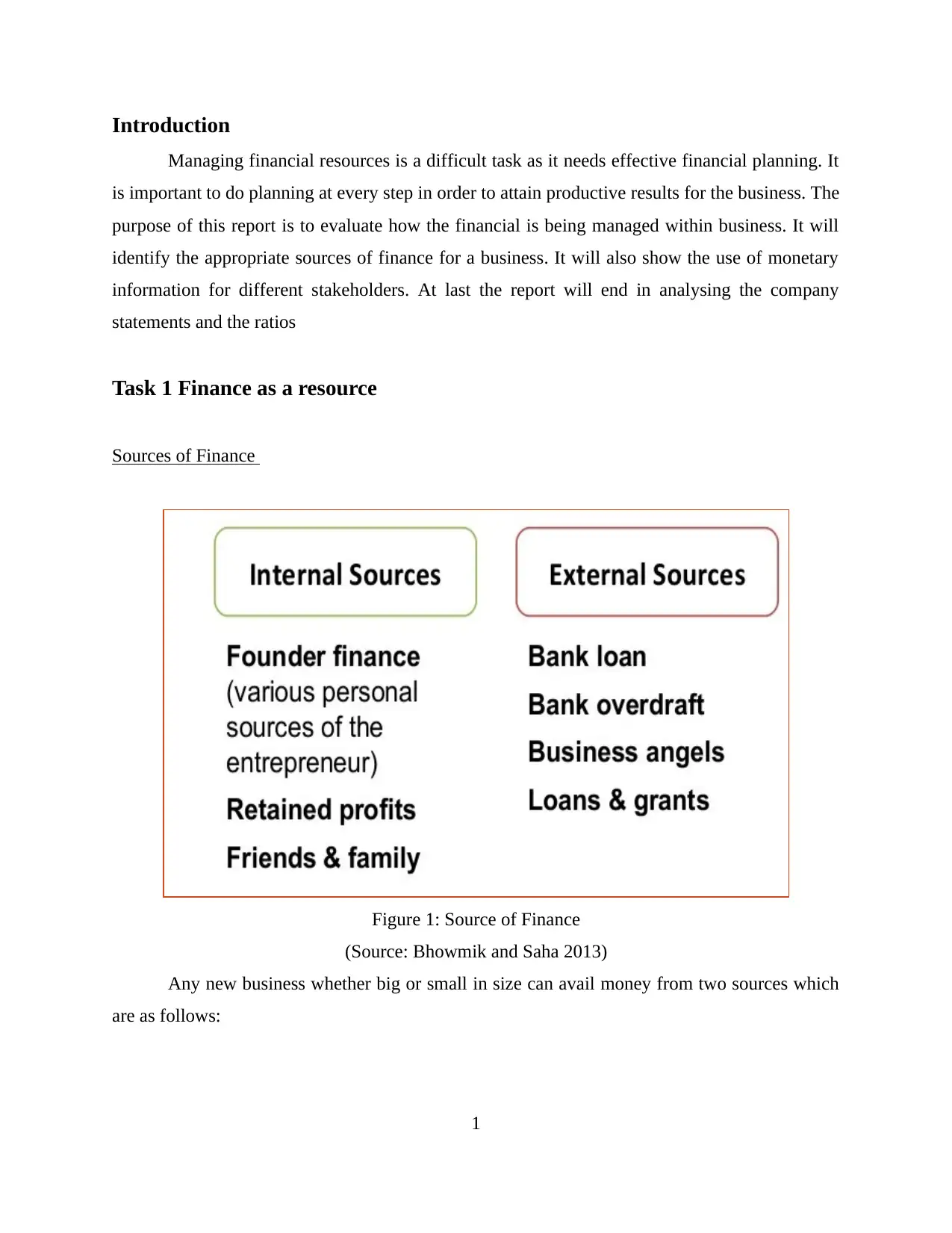
Introduction
Managing financial resources is a difficult task as it needs effective financial planning. It
is important to do planning at every step in order to attain productive results for the business. The
purpose of this report is to evaluate how the financial is being managed within business. It will
identify the appropriate sources of finance for a business. It will also show the use of monetary
information for different stakeholders. At last the report will end in analysing the company
statements and the ratios
Task 1 Finance as a resource
Sources of Finance
Figure 1: Source of Finance
(Source: Bhowmik and Saha 2013)
Any new business whether big or small in size can avail money from two sources which
are as follows:
1
Managing financial resources is a difficult task as it needs effective financial planning. It
is important to do planning at every step in order to attain productive results for the business. The
purpose of this report is to evaluate how the financial is being managed within business. It will
identify the appropriate sources of finance for a business. It will also show the use of monetary
information for different stakeholders. At last the report will end in analysing the company
statements and the ratios
Task 1 Finance as a resource
Sources of Finance
Figure 1: Source of Finance
(Source: Bhowmik and Saha 2013)
Any new business whether big or small in size can avail money from two sources which
are as follows:
1
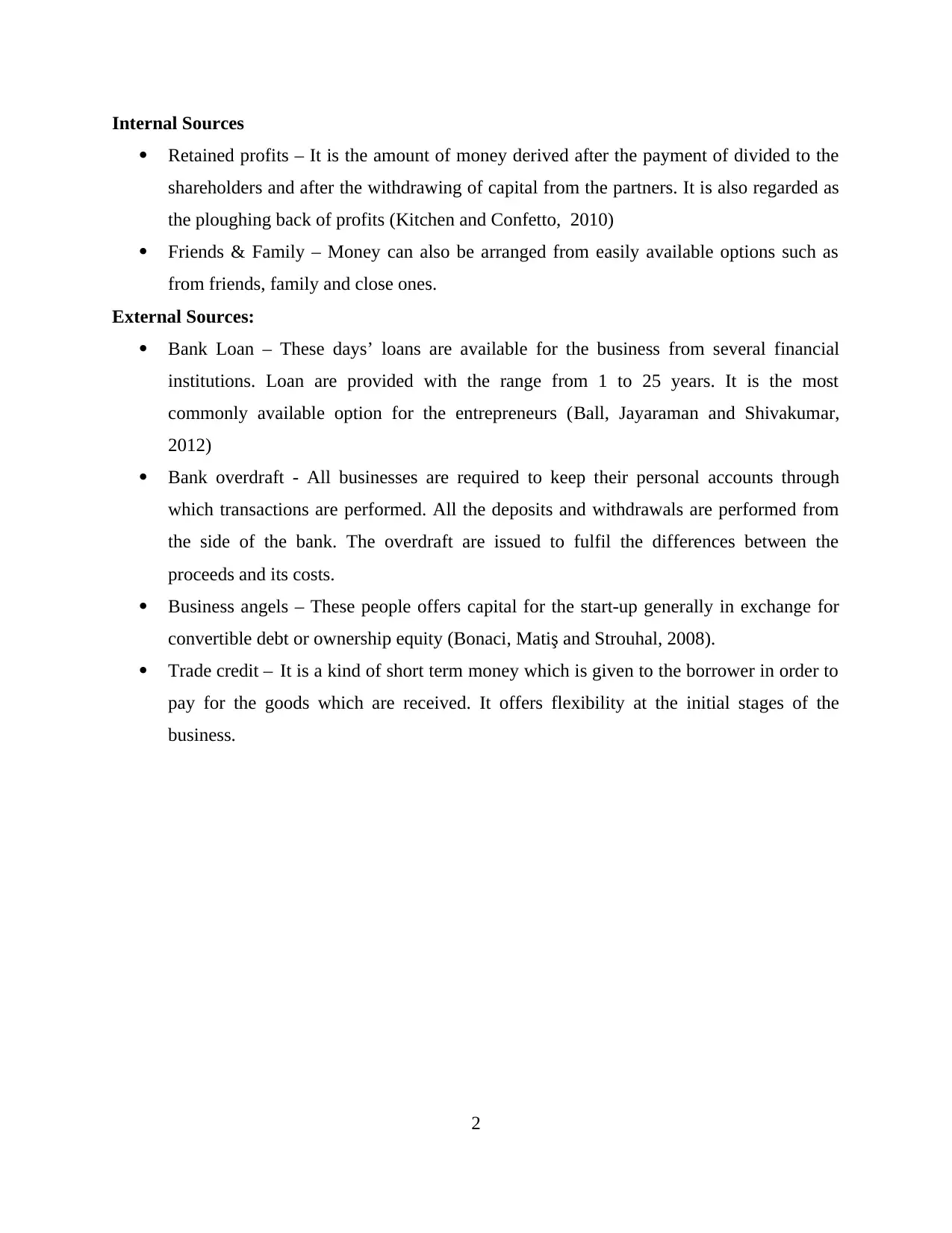
Internal Sources
Retained profits – It is the amount of money derived after the payment of divided to the
shareholders and after the withdrawing of capital from the partners. It is also regarded as
the ploughing back of profits (Kitchen and Confetto, 2010)
Friends & Family – Money can also be arranged from easily available options such as
from friends, family and close ones.
External Sources:
Bank Loan – These days’ loans are available for the business from several financial
institutions. Loan are provided with the range from 1 to 25 years. It is the most
commonly available option for the entrepreneurs (Ball, Jayaraman and Shivakumar,
2012)
Bank overdraft - All businesses are required to keep their personal accounts through
which transactions are performed. All the deposits and withdrawals are performed from
the side of the bank. The overdraft are issued to fulfil the differences between the
proceeds and its costs.
Business angels – These people offers capital for the start-up generally in exchange for
convertible debt or ownership equity (Bonaci, Matiş and Strouhal, 2008).
Trade credit – It is a kind of short term money which is given to the borrower in order to
pay for the goods which are received. It offers flexibility at the initial stages of the
business.
2
Retained profits – It is the amount of money derived after the payment of divided to the
shareholders and after the withdrawing of capital from the partners. It is also regarded as
the ploughing back of profits (Kitchen and Confetto, 2010)
Friends & Family – Money can also be arranged from easily available options such as
from friends, family and close ones.
External Sources:
Bank Loan – These days’ loans are available for the business from several financial
institutions. Loan are provided with the range from 1 to 25 years. It is the most
commonly available option for the entrepreneurs (Ball, Jayaraman and Shivakumar,
2012)
Bank overdraft - All businesses are required to keep their personal accounts through
which transactions are performed. All the deposits and withdrawals are performed from
the side of the bank. The overdraft are issued to fulfil the differences between the
proceeds and its costs.
Business angels – These people offers capital for the start-up generally in exchange for
convertible debt or ownership equity (Bonaci, Matiş and Strouhal, 2008).
Trade credit – It is a kind of short term money which is given to the borrower in order to
pay for the goods which are received. It offers flexibility at the initial stages of the
business.
2
⊘ This is a preview!⊘
Do you want full access?
Subscribe today to unlock all pages.

Trusted by 1+ million students worldwide
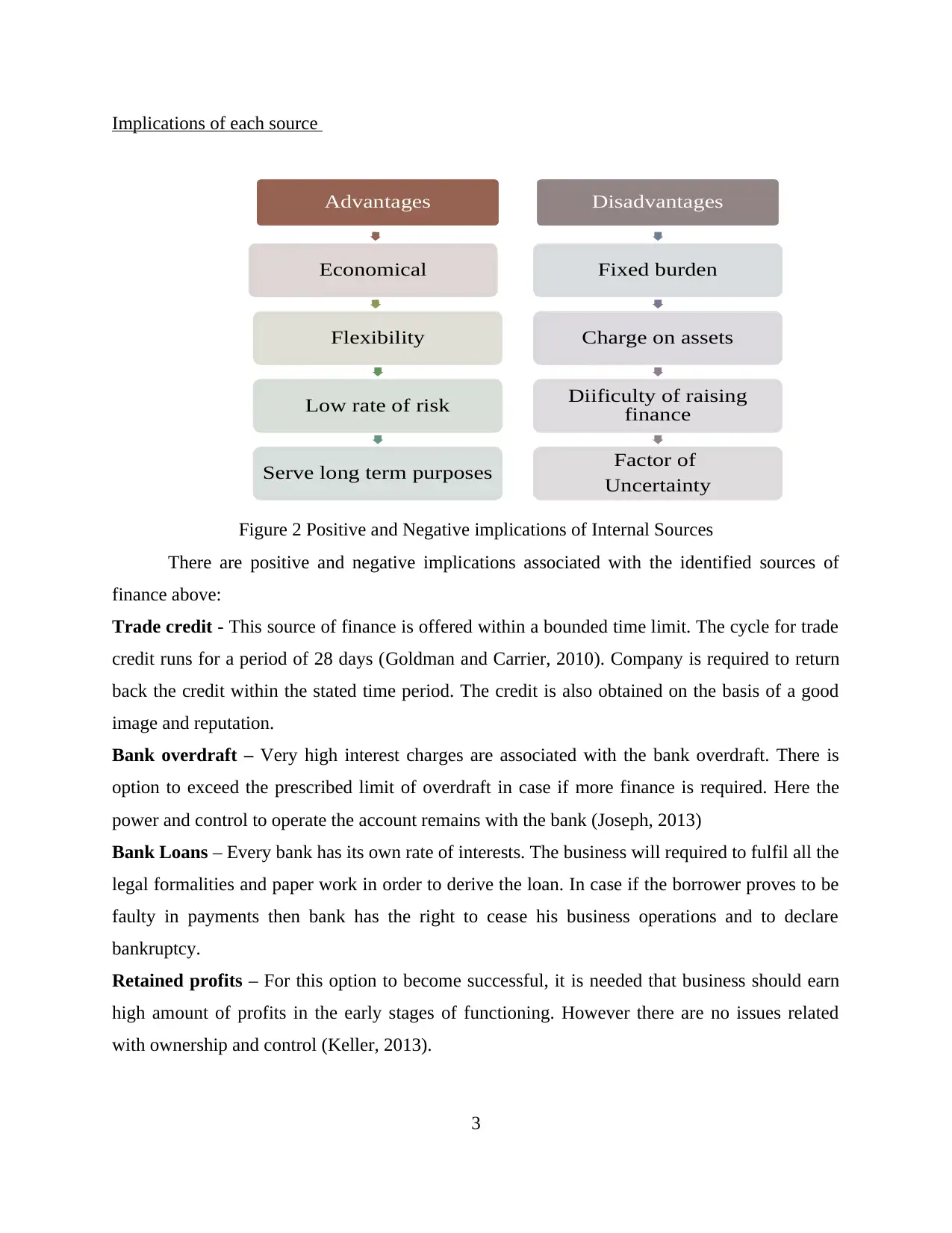
Implications of each source
Figure 2 Positive and Negative implications of Internal Sources
There are positive and negative implications associated with the identified sources of
finance above:
Trade credit - This source of finance is offered within a bounded time limit. The cycle for trade
credit runs for a period of 28 days (Goldman and Carrier, 2010). Company is required to return
back the credit within the stated time period. The credit is also obtained on the basis of a good
image and reputation.
Bank overdraft – Very high interest charges are associated with the bank overdraft. There is
option to exceed the prescribed limit of overdraft in case if more finance is required. Here the
power and control to operate the account remains with the bank (Joseph, 2013)
Bank Loans – Every bank has its own rate of interests. The business will required to fulfil all the
legal formalities and paper work in order to derive the loan. In case if the borrower proves to be
faulty in payments then bank has the right to cease his business operations and to declare
bankruptcy.
Retained profits – For this option to become successful, it is needed that business should earn
high amount of profits in the early stages of functioning. However there are no issues related
with ownership and control (Keller, 2013).
3
Advantages
Economical
Flexibility
Low rate of risk
Serve long term purposes
Disadvantages
Fixed burden
Charge on assets
Diificulty of raising
finance
Factor of
Uncertainty
Figure 2 Positive and Negative implications of Internal Sources
There are positive and negative implications associated with the identified sources of
finance above:
Trade credit - This source of finance is offered within a bounded time limit. The cycle for trade
credit runs for a period of 28 days (Goldman and Carrier, 2010). Company is required to return
back the credit within the stated time period. The credit is also obtained on the basis of a good
image and reputation.
Bank overdraft – Very high interest charges are associated with the bank overdraft. There is
option to exceed the prescribed limit of overdraft in case if more finance is required. Here the
power and control to operate the account remains with the bank (Joseph, 2013)
Bank Loans – Every bank has its own rate of interests. The business will required to fulfil all the
legal formalities and paper work in order to derive the loan. In case if the borrower proves to be
faulty in payments then bank has the right to cease his business operations and to declare
bankruptcy.
Retained profits – For this option to become successful, it is needed that business should earn
high amount of profits in the early stages of functioning. However there are no issues related
with ownership and control (Keller, 2013).
3
Advantages
Economical
Flexibility
Low rate of risk
Serve long term purposes
Disadvantages
Fixed burden
Charge on assets
Diificulty of raising
finance
Factor of
Uncertainty
Paraphrase This Document
Need a fresh take? Get an instant paraphrase of this document with our AI Paraphraser
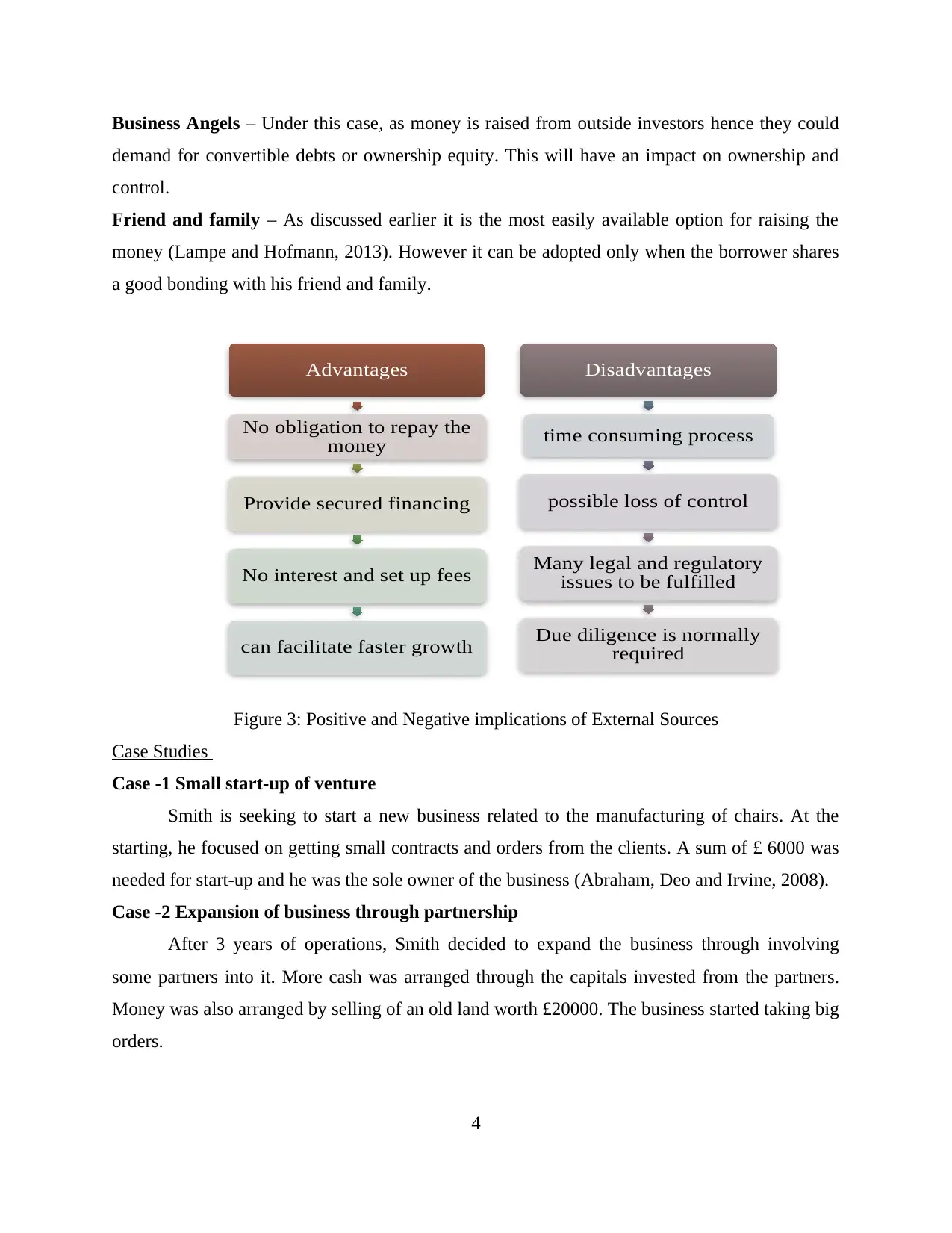
Business Angels – Under this case, as money is raised from outside investors hence they could
demand for convertible debts or ownership equity. This will have an impact on ownership and
control.
Friend and family – As discussed earlier it is the most easily available option for raising the
money (Lampe and Hofmann, 2013). However it can be adopted only when the borrower shares
a good bonding with his friend and family.
Figure 3: Positive and Negative implications of External Sources
Case Studies
Case -1 Small start-up of venture
Smith is seeking to start a new business related to the manufacturing of chairs. At the
starting, he focused on getting small contracts and orders from the clients. A sum of £ 6000 was
needed for start-up and he was the sole owner of the business (Abraham, Deo and Irvine, 2008).
Case -2 Expansion of business through partnership
After 3 years of operations, Smith decided to expand the business through involving
some partners into it. More cash was arranged through the capitals invested from the partners.
Money was also arranged by selling of an old land worth £20000. The business started taking big
orders.
4
Advantages
No obligation to repay the
money
Provide secured financing
No interest and set up fees
can facilitate faster growth
Disadvantages
time consuming process
possible loss of control
Many legal and regulatory
issues to be fulfilled
Due diligence is normally
required
demand for convertible debts or ownership equity. This will have an impact on ownership and
control.
Friend and family – As discussed earlier it is the most easily available option for raising the
money (Lampe and Hofmann, 2013). However it can be adopted only when the borrower shares
a good bonding with his friend and family.
Figure 3: Positive and Negative implications of External Sources
Case Studies
Case -1 Small start-up of venture
Smith is seeking to start a new business related to the manufacturing of chairs. At the
starting, he focused on getting small contracts and orders from the clients. A sum of £ 6000 was
needed for start-up and he was the sole owner of the business (Abraham, Deo and Irvine, 2008).
Case -2 Expansion of business through partnership
After 3 years of operations, Smith decided to expand the business through involving
some partners into it. More cash was arranged through the capitals invested from the partners.
Money was also arranged by selling of an old land worth £20000. The business started taking big
orders.
4
Advantages
No obligation to repay the
money
Provide secured financing
No interest and set up fees
can facilitate faster growth
Disadvantages
time consuming process
possible loss of control
Many legal and regulatory
issues to be fulfilled
Due diligence is normally
required
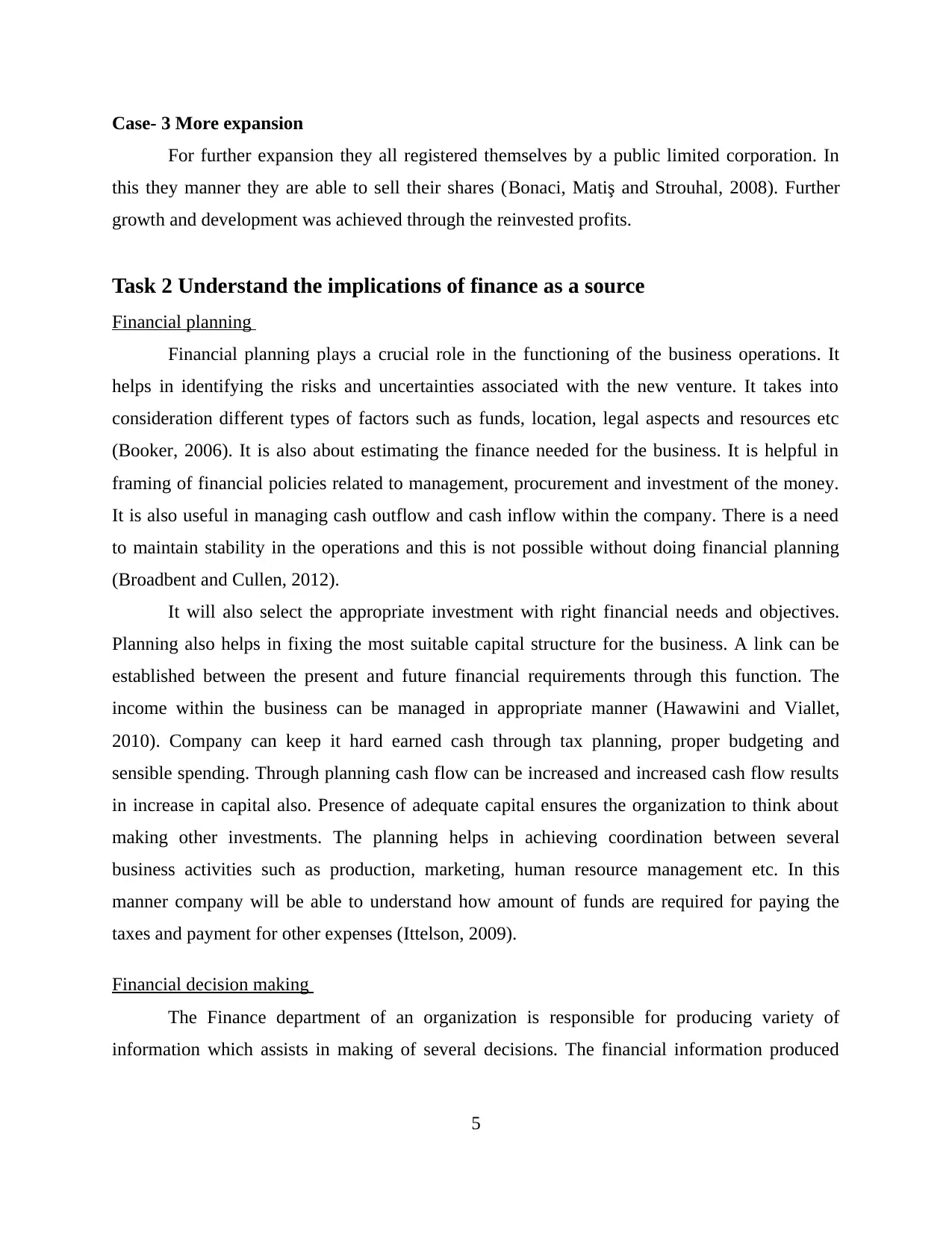
Case- 3 More expansion
For further expansion they all registered themselves by a public limited corporation. In
this they manner they are able to sell their shares (Bonaci, Matiş and Strouhal, 2008). Further
growth and development was achieved through the reinvested profits.
Task 2 Understand the implications of finance as a source
Financial planning
Financial planning plays a crucial role in the functioning of the business operations. It
helps in identifying the risks and uncertainties associated with the new venture. It takes into
consideration different types of factors such as funds, location, legal aspects and resources etc
(Booker, 2006). It is also about estimating the finance needed for the business. It is helpful in
framing of financial policies related to management, procurement and investment of the money.
It is also useful in managing cash outflow and cash inflow within the company. There is a need
to maintain stability in the operations and this is not possible without doing financial planning
(Broadbent and Cullen, 2012).
It will also select the appropriate investment with right financial needs and objectives.
Planning also helps in fixing the most suitable capital structure for the business. A link can be
established between the present and future financial requirements through this function. The
income within the business can be managed in appropriate manner (Hawawini and Viallet,
2010). Company can keep it hard earned cash through tax planning, proper budgeting and
sensible spending. Through planning cash flow can be increased and increased cash flow results
in increase in capital also. Presence of adequate capital ensures the organization to think about
making other investments. The planning helps in achieving coordination between several
business activities such as production, marketing, human resource management etc. In this
manner company will be able to understand how amount of funds are required for paying the
taxes and payment for other expenses (Ittelson, 2009).
Financial decision making
The Finance department of an organization is responsible for producing variety of
information which assists in making of several decisions. The financial information produced
5
For further expansion they all registered themselves by a public limited corporation. In
this they manner they are able to sell their shares (Bonaci, Matiş and Strouhal, 2008). Further
growth and development was achieved through the reinvested profits.
Task 2 Understand the implications of finance as a source
Financial planning
Financial planning plays a crucial role in the functioning of the business operations. It
helps in identifying the risks and uncertainties associated with the new venture. It takes into
consideration different types of factors such as funds, location, legal aspects and resources etc
(Booker, 2006). It is also about estimating the finance needed for the business. It is helpful in
framing of financial policies related to management, procurement and investment of the money.
It is also useful in managing cash outflow and cash inflow within the company. There is a need
to maintain stability in the operations and this is not possible without doing financial planning
(Broadbent and Cullen, 2012).
It will also select the appropriate investment with right financial needs and objectives.
Planning also helps in fixing the most suitable capital structure for the business. A link can be
established between the present and future financial requirements through this function. The
income within the business can be managed in appropriate manner (Hawawini and Viallet,
2010). Company can keep it hard earned cash through tax planning, proper budgeting and
sensible spending. Through planning cash flow can be increased and increased cash flow results
in increase in capital also. Presence of adequate capital ensures the organization to think about
making other investments. The planning helps in achieving coordination between several
business activities such as production, marketing, human resource management etc. In this
manner company will be able to understand how amount of funds are required for paying the
taxes and payment for other expenses (Ittelson, 2009).
Financial decision making
The Finance department of an organization is responsible for producing variety of
information which assists in making of several decisions. The financial information produced
5
⊘ This is a preview!⊘
Do you want full access?
Subscribe today to unlock all pages.

Trusted by 1+ million students worldwide
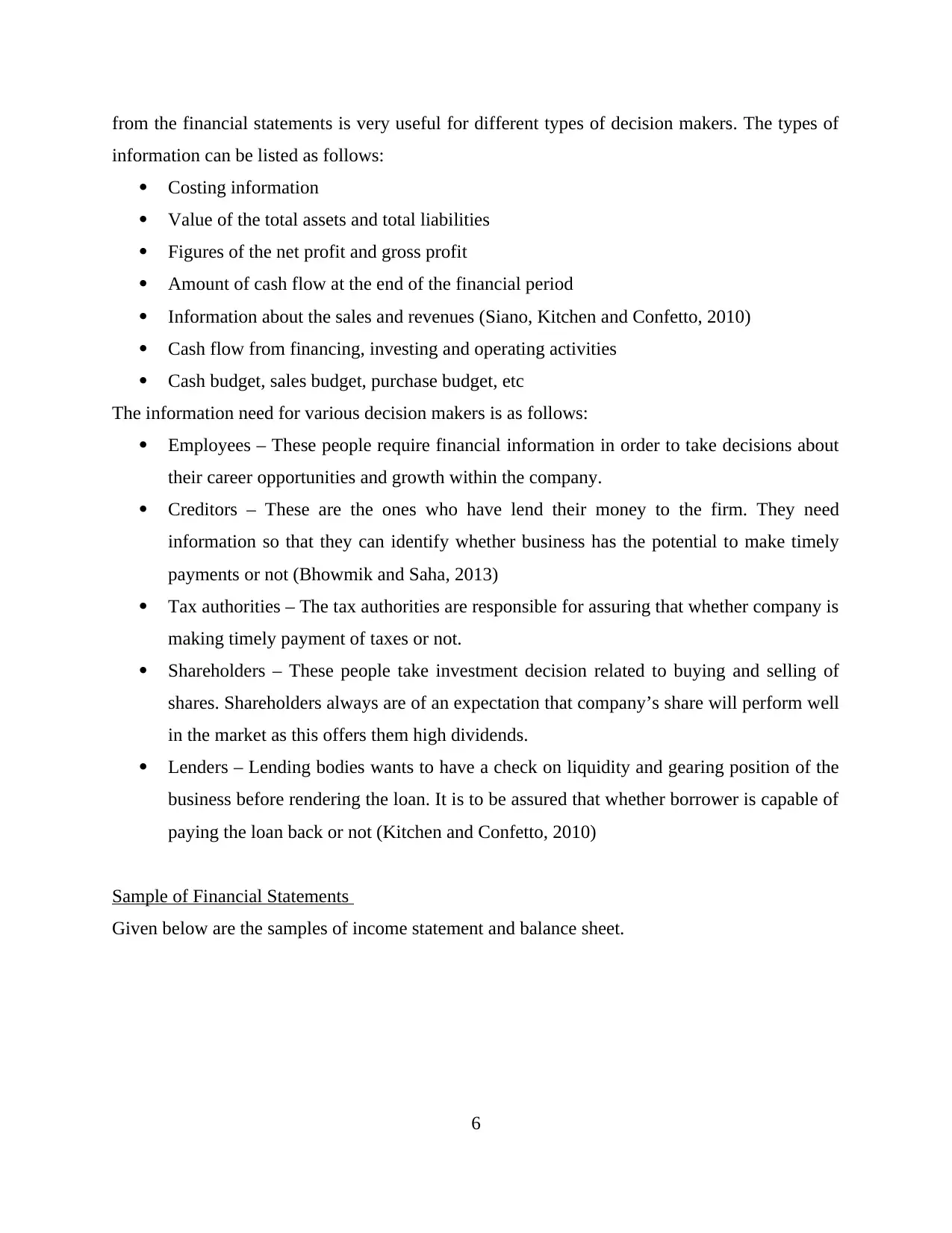
from the financial statements is very useful for different types of decision makers. The types of
information can be listed as follows:
Costing information
Value of the total assets and total liabilities
Figures of the net profit and gross profit
Amount of cash flow at the end of the financial period
Information about the sales and revenues (Siano, Kitchen and Confetto, 2010)
Cash flow from financing, investing and operating activities
Cash budget, sales budget, purchase budget, etc
The information need for various decision makers is as follows:
Employees – These people require financial information in order to take decisions about
their career opportunities and growth within the company.
Creditors – These are the ones who have lend their money to the firm. They need
information so that they can identify whether business has the potential to make timely
payments or not (Bhowmik and Saha, 2013)
Tax authorities – The tax authorities are responsible for assuring that whether company is
making timely payment of taxes or not.
Shareholders – These people take investment decision related to buying and selling of
shares. Shareholders always are of an expectation that company’s share will perform well
in the market as this offers them high dividends.
Lenders – Lending bodies wants to have a check on liquidity and gearing position of the
business before rendering the loan. It is to be assured that whether borrower is capable of
paying the loan back or not (Kitchen and Confetto, 2010)
Sample of Financial Statements
Given below are the samples of income statement and balance sheet.
6
information can be listed as follows:
Costing information
Value of the total assets and total liabilities
Figures of the net profit and gross profit
Amount of cash flow at the end of the financial period
Information about the sales and revenues (Siano, Kitchen and Confetto, 2010)
Cash flow from financing, investing and operating activities
Cash budget, sales budget, purchase budget, etc
The information need for various decision makers is as follows:
Employees – These people require financial information in order to take decisions about
their career opportunities and growth within the company.
Creditors – These are the ones who have lend their money to the firm. They need
information so that they can identify whether business has the potential to make timely
payments or not (Bhowmik and Saha, 2013)
Tax authorities – The tax authorities are responsible for assuring that whether company is
making timely payment of taxes or not.
Shareholders – These people take investment decision related to buying and selling of
shares. Shareholders always are of an expectation that company’s share will perform well
in the market as this offers them high dividends.
Lenders – Lending bodies wants to have a check on liquidity and gearing position of the
business before rendering the loan. It is to be assured that whether borrower is capable of
paying the loan back or not (Kitchen and Confetto, 2010)
Sample of Financial Statements
Given below are the samples of income statement and balance sheet.
6
Paraphrase This Document
Need a fresh take? Get an instant paraphrase of this document with our AI Paraphraser
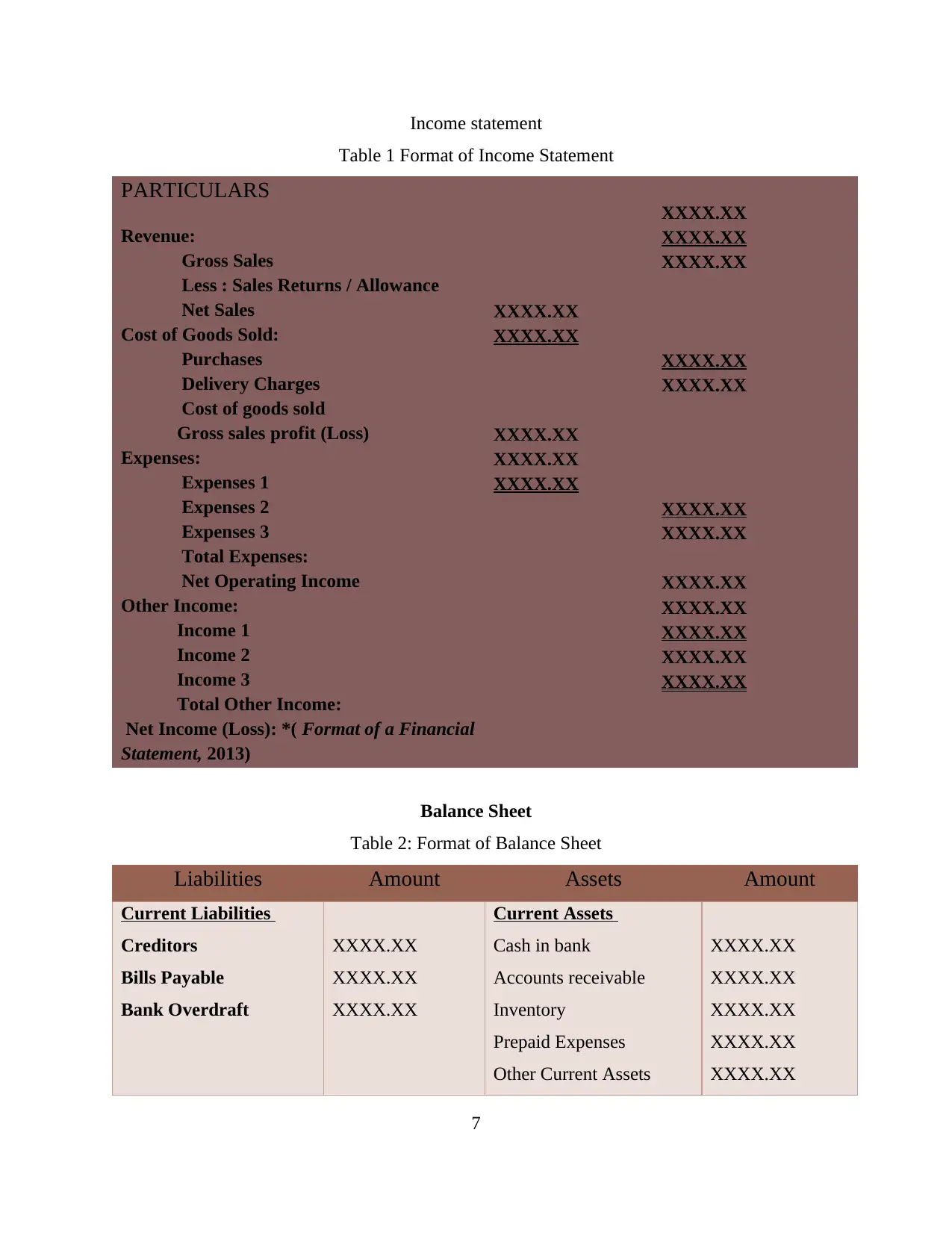
Income statement
Table 1 Format of Income Statement
PARTICULARS
Revenue:
Gross Sales
Less : Sales Returns / Allowance
Net Sales
Cost of Goods Sold:
Purchases
Delivery Charges
Cost of goods sold
Gross sales profit (Loss)
Expenses:
Expenses 1
Expenses 2
Expenses 3
Total Expenses:
Net Operating Income
Other Income:
Income 1
Income 2
Income 3
Total Other Income:
Net Income (Loss): *( Format of a Financial
Statement, 2013)
XXXX.XX
XXXX.XX
XXXX.XX
XXXX.XX
XXXX.XX
XXXX.XX
XXXX.XX
XXXX.XX
XXXX.XX
XXXX.XX
XXXX.XX
XXXX.XX
XXXX.XX
XXXX.XX
XXXX.XX
XXXX.XX
XXXX.XX
Balance Sheet
Table 2: Format of Balance Sheet
Liabilities Amount Assets Amount
Current Liabilities
Creditors
Bills Payable
Bank Overdraft
XXXX.XX
XXXX.XX
XXXX.XX
Current Assets
Cash in bank
Accounts receivable
Inventory
Prepaid Expenses
Other Current Assets
XXXX.XX
XXXX.XX
XXXX.XX
XXXX.XX
XXXX.XX
7
Table 1 Format of Income Statement
PARTICULARS
Revenue:
Gross Sales
Less : Sales Returns / Allowance
Net Sales
Cost of Goods Sold:
Purchases
Delivery Charges
Cost of goods sold
Gross sales profit (Loss)
Expenses:
Expenses 1
Expenses 2
Expenses 3
Total Expenses:
Net Operating Income
Other Income:
Income 1
Income 2
Income 3
Total Other Income:
Net Income (Loss): *( Format of a Financial
Statement, 2013)
XXXX.XX
XXXX.XX
XXXX.XX
XXXX.XX
XXXX.XX
XXXX.XX
XXXX.XX
XXXX.XX
XXXX.XX
XXXX.XX
XXXX.XX
XXXX.XX
XXXX.XX
XXXX.XX
XXXX.XX
XXXX.XX
XXXX.XX
Balance Sheet
Table 2: Format of Balance Sheet
Liabilities Amount Assets Amount
Current Liabilities
Creditors
Bills Payable
Bank Overdraft
XXXX.XX
XXXX.XX
XXXX.XX
Current Assets
Cash in bank
Accounts receivable
Inventory
Prepaid Expenses
Other Current Assets
XXXX.XX
XXXX.XX
XXXX.XX
XXXX.XX
XXXX.XX
7
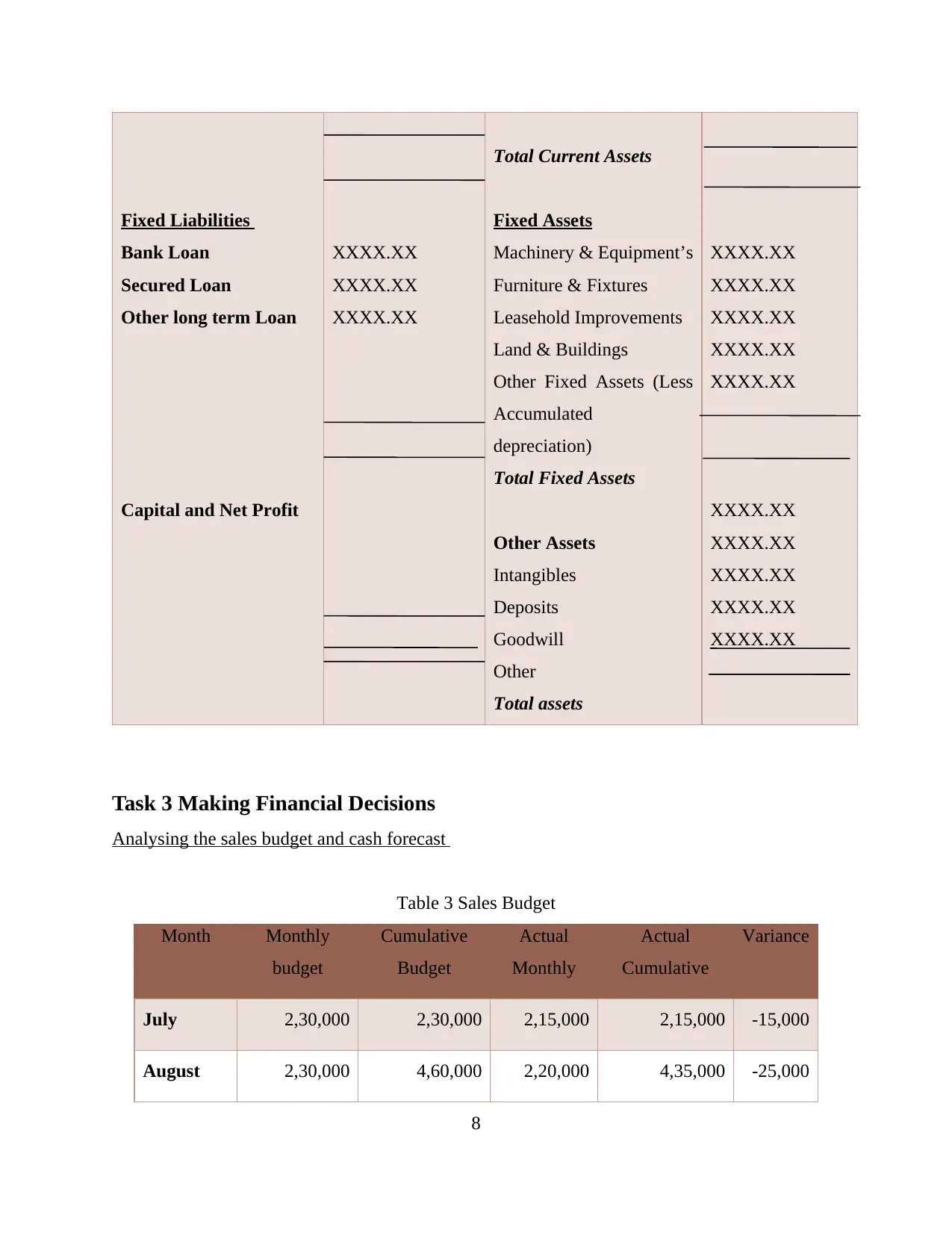
Fixed Liabilities
Bank Loan
Secured Loan
Other long term Loan
Capital and Net Profit
XXXX.XX
XXXX.XX
XXXX.XX
Total Current Assets
Fixed Assets
Machinery & Equipment’s
Furniture & Fixtures
Leasehold Improvements
Land & Buildings
Other Fixed Assets (Less
Accumulated
depreciation)
Total Fixed Assets
Other Assets
Intangibles
Deposits
Goodwill
Other
Total assets
XXXX.XX
XXXX.XX
XXXX.XX
XXXX.XX
XXXX.XX
XXXX.XX
XXXX.XX
XXXX.XX
XXXX.XX
XXXX.XX
Task 3 Making Financial Decisions
Analysing the sales budget and cash forecast
Table 3 Sales Budget
Month Monthly
budget
Cumulative
Budget
Actual
Monthly
Actual
Cumulative
Variance
July 2,30,000 2,30,000 2,15,000 2,15,000 -15,000
August 2,30,000 4,60,000 2,20,000 4,35,000 -25,000
8
Bank Loan
Secured Loan
Other long term Loan
Capital and Net Profit
XXXX.XX
XXXX.XX
XXXX.XX
Total Current Assets
Fixed Assets
Machinery & Equipment’s
Furniture & Fixtures
Leasehold Improvements
Land & Buildings
Other Fixed Assets (Less
Accumulated
depreciation)
Total Fixed Assets
Other Assets
Intangibles
Deposits
Goodwill
Other
Total assets
XXXX.XX
XXXX.XX
XXXX.XX
XXXX.XX
XXXX.XX
XXXX.XX
XXXX.XX
XXXX.XX
XXXX.XX
XXXX.XX
Task 3 Making Financial Decisions
Analysing the sales budget and cash forecast
Table 3 Sales Budget
Month Monthly
budget
Cumulative
Budget
Actual
Monthly
Actual
Cumulative
Variance
July 2,30,000 2,30,000 2,15,000 2,15,000 -15,000
August 2,30,000 4,60,000 2,20,000 4,35,000 -25,000
8
⊘ This is a preview!⊘
Do you want full access?
Subscribe today to unlock all pages.

Trusted by 1+ million students worldwide
1 out of 24
Related Documents
Your All-in-One AI-Powered Toolkit for Academic Success.
+13062052269
info@desklib.com
Available 24*7 on WhatsApp / Email
![[object Object]](/_next/static/media/star-bottom.7253800d.svg)
Unlock your academic potential
Copyright © 2020–2025 A2Z Services. All Rights Reserved. Developed and managed by ZUCOL.





